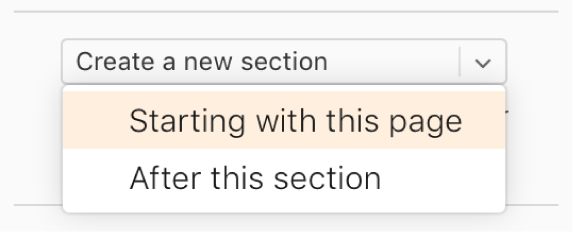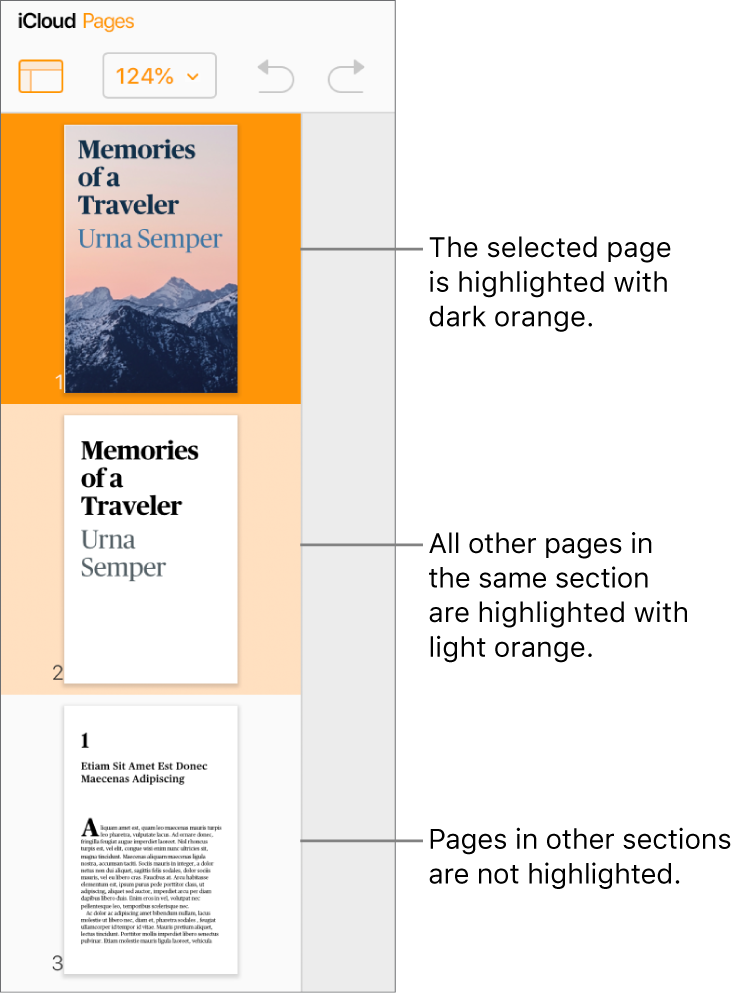
Add sections in Pages for iCloud
If you’re working in a word-processing document, you can divide it into multiple sections, so that different parts of your content (such as book chapters or report segments) can use different page numbering styles, headers, footers, and backgrounds. You might want to do this, for example, to use section-specific chapter titles in headers or to vary the visual design of a section.
All sections begin at the top of a new page. You can divide the current section into two sections starting at the insertion point or at the top of the current page, or you can add a new empty section after the current section.
After you add a new section, you can format it. You can also see which pages belong to a section in Page Thumbnails view.
Start a new section at the insertion point
You can add a new section anywhere you place the insertion point. If the insertion point is at the start of a paragraph, for instance, the new section begins with that paragraph at the top of a new page. This effectively divides the current section into two sections.
Click anywhere in your document to place the insertion point where you want the new section to start.
Click the Insert button
 in the toolbar, then choose Section Break.
in the toolbar, then choose Section Break.Any content before the insertion point remains part of the original section, and content following the insertion point becomes part of a new section at the start of a new page.
Start a new section at the top of the current page
You can create a new section that begins with the content on the current page (as long as it’s not the first page of the document or section). This effectively divides the current section into two sections.
In Page Thumbnails view, select the page you want to make the start of a new section, or click anywhere in the section you want to the new section to follow.
Open the Document
 sidebar, then click the Section tab at the top.
sidebar, then click the Section tab at the top.Click the “Create a new section” pop-up menu, then choose "Starting with this page.”

If “Starting with this page” is dimmed, make sure you haven’t selected the first page of the document or section. To add a new section at the beginning of a document or section, you need to start the new section at the insertion point, as described in the previous task.
Add a new empty section after the current section
In Page Thumbnails view, select any page in the section that comes before where you want to add a new section.
Open the Document
 sidebar, then click the Section tab at the top.
sidebar, then click the Section tab at the top.Click the “Create a new section” pop-up menu, then choose “After this section.”

Format a section
When you change the background, headers, footers, and page numbering style for a section, the changes are applied to all pages in the current section.
In Page Thumbnails view, select any page in the section you want to format.
Open the Document
 sidebar, then click the Section tab at the top.
sidebar, then click the Section tab at the top.To change the background color for this section, select the Background checkbox, click the color well to the right of the checkbox (it looks like a rectangle) and choose a color.
You can also add an image, or a custom color or gradient (two colors that blend into one another) to the background. For more information, see Change the page background.
To choose header and footer options, Below Headers & Footers, do any of the following:
Show headers and footers on all but the first page of the section: Select the “Hide on first page of section” checkbox.
Use different headers and footers on left and right pages (for documents with facing pages): Select the “Left and right pages are different” checkbox.
Use different page numbers, headers, or footers from the previous section: Deselect the “Match previous section” checkbox.
To choose how page numbers appear, Below Page Numbering, do any of the following:
Choose a whole number, roman numeral, or alphabetical numbering format: Click the Format pop-up menu, then choose an option.
Continue page numbers from the previous section: Select “Continue from previous section.”
Choose the page number you want to start this section with: Select “Start at,” then enter the page number you want this section to start with (or click the up or down arrows).
If this document is set up to use facing pages, click the pop-up menu to the right of “Section starts on,” then choose an option to determine where the section content starts:
Next: Starts the section on either a left or right page, whichever comes next in the document. If you don’t want your document to include blank pages, choose Next.
Right: Starts the section on the first right page. If the next page in your document would be a left-side page, a blank page is inserted before the start of the section on the right.
Left: Starts the section on the first left page. If the next page in your document would be a right-side page, a blank page is inserted before the start of the section on the left.
View a document’s sections
By default (unless you start with a template that already has multiple sections), all pages in a word-processing document are part of the same section until you choose to add additional sections. You can see which pages in a word-processing document belong to a particular section in Page Thumbnails view.
Note: In page layout documents, each page is its own section (you can’t divide page layout pages into additional sections).
Click the View button
 in the toolbar, choose Page Thumbnails, then click a page thumbnail in the sidebar. A highlight appears behind all the pages in the same section.
in the toolbar, choose Page Thumbnails, then click a page thumbnail in the sidebar. A highlight appears behind all the pages in the same section.
Adding sections to a word-processing document can also make it easier to rearrange, duplicate, or delete specific portions of content. See Rearrange pages or sections, Duplicate pages or sections, or Delete pages or sections.